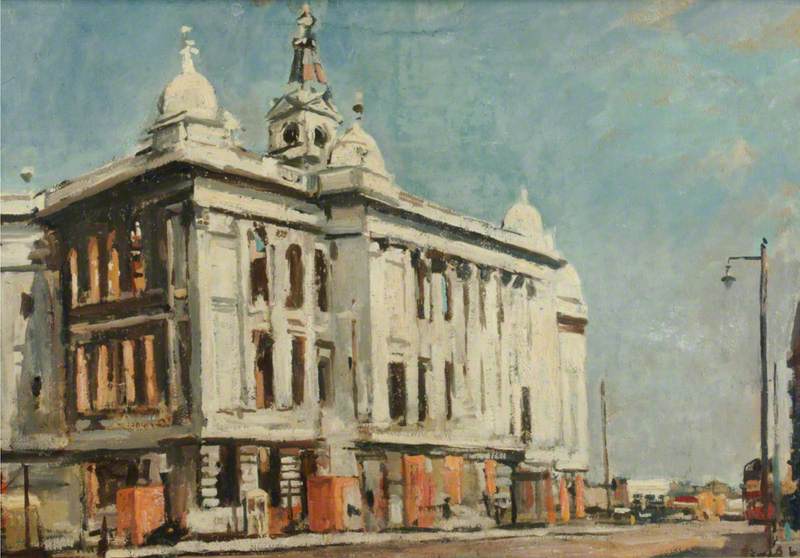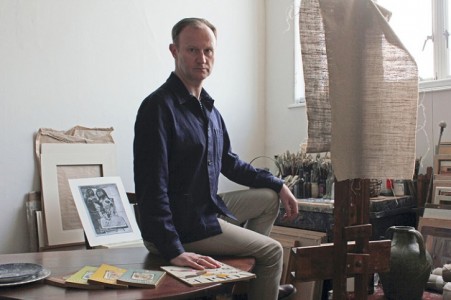Edward Robert King was born in 1863 in Kensington, London into a middle-class family. As a child he had an early introduction to art; every year his father would take him and his brother Gunning to Eastbourne where they would all go sketching. At the age of fourteen he started to sell his paintings in Tottenham Court Road for five shillings each, and at the same time he played the violin in the Covent Garden Orchestra. In 1878 at the age of fifteen he and his brother were sent to Leipzig in Germany to study both art and music, returning to London in their late teens.
Edward had art training in Paris at the Julian Academy and then briefly at the Slade School of Art. It was around this time he became friends with Walter Sickert, James McNeill Whistler and John Atkinson Grimshaw. He found work initially as an illustrator, and in the 1880s his sketches were published in Punch magazine, and the Illustrated London News. His sympathetic treatment of gritty rural and urban subjects was admired by Vincent van Gogh, who admired King's 'striking, powerful virile drawing'.
In 1888 Edward was elected a member of the New English Art Club, and from then until 1924 he exhibited over 50 works at the Royal Academy. During this time he lived in South Harting near Petersfield with his brother Gunning, who was also making a successful career as an artist. In 1895 Edward married Amelia Emily Hudson and they initially settled in Cornwall. Between 1912–1924 he travelled a great deal and lived in various places including Dorset, Devon and Sussex, painting mostly figurative scenes.
In 1924 Edward King's wife died and just as his work was gaining wider recognition, he suffered a breakdown. Suffering with depression, he was committed to St James' Hospital in Portsmouth in 1926, where he remained until his death in 1951.
For many years as a patient he was in an unresponsive state but over time was encouraged by the hospital staff to start painting again. In 1941, during the Second World War, he was commissioned by the Lord Mayor to paint the aftermath of the Blitz in Portsmouth. From this point he continued to paint daily, focusing on landscapes and coastal scenes of the local area, right up until he died at 88 years old, in 1951.
Cabbage Field on the Farm at St James' Hospital
1941
Edward Robert King (1863–1951) 
A series of his paintings depicting Portsmouth during the Blitz are at the heart of a current collection display at Portsmouth City Museum, 'Edward King: A Life in Art'. King's impressionistic style is evident in his series of Blitz paintings and complements the forms and colour of the demolished brickwork. The exhibition brings together around 70 paintings, including the Blitz series, as well as photographs, archival material and objects from Portsmouth's museum collections.
The display is in three sections – the first focuses on the Blitz and the aftermath of the Second World War bombing in Portsmouth. Edward King's series of works shown here are the ones commissioned by the Lord Mayor. They capture a significant moment in Portsmouth's history and enable people to engage with history through art.
St Thomas' Street, Portsmouth
1941
Edward Robert King (1863–1951) 
High Street, Old Portsmouth
1942
Edward Robert King (1863–1951) 
The second section focuses on St James Hospital, where Edward King lived for 25 years. He was given access to the vast grounds to paint daily – the area included large farming areas, tree-lined avenues of poplars and Cyprus trees, and a variety of out-buildings which where the focus of his attention. Again, King's paintings have captured a moment in history, as the majority of this area has since been redeveloped and used for housing.
The final section dwells upon King in the last years of his life, painting at the Milton Harbour area which neighboured the grounds of the hospital. He would be there every day from dawn to dusk, painting the houseboats and vessels of the coastal shanty town that was home to many who had been displaced after the Second World War. This area is almost unrecognisable today as to when King painted there.
Houseboats at Milton alongside a Quay, with a Girl in Red
1946
Edward Robert King (1863–1951) 
The majority of his works that feature on the Art UK website are currently in this exhibition, with the exception of a few works that need conservation treatment, or are on the reverse of other works: given the sparse availability of painting materials in the years after the war, King often used both sides of the painting board. Although he was a well-known figure in the area and built up good relationships with people to the extent of having a reciprocal exchange – they would supply him with paints and boards and he would give them a painting in return.
The exhibition reveals a unique collection that represents a fascinating combination of fine art and local history; many of the buildings recorded by King were demolished for safety reasons in the post-war redevelopment of the city. King captured an important piece of Portsmouth's history, the devastation caused by the Blitz, which ultimately shaped the city as we know it today.
Susan Ward, Curator of Art, Portsmouth City Museum
'Edward King: A Life in Art' was on display at Portsmouth City Museum until 2017




















